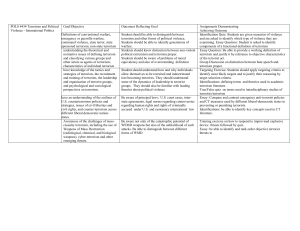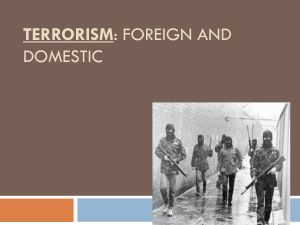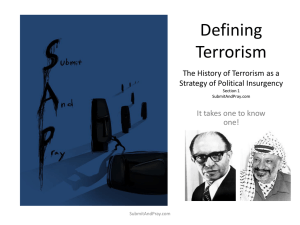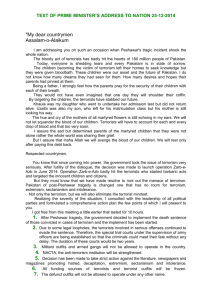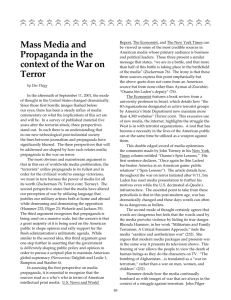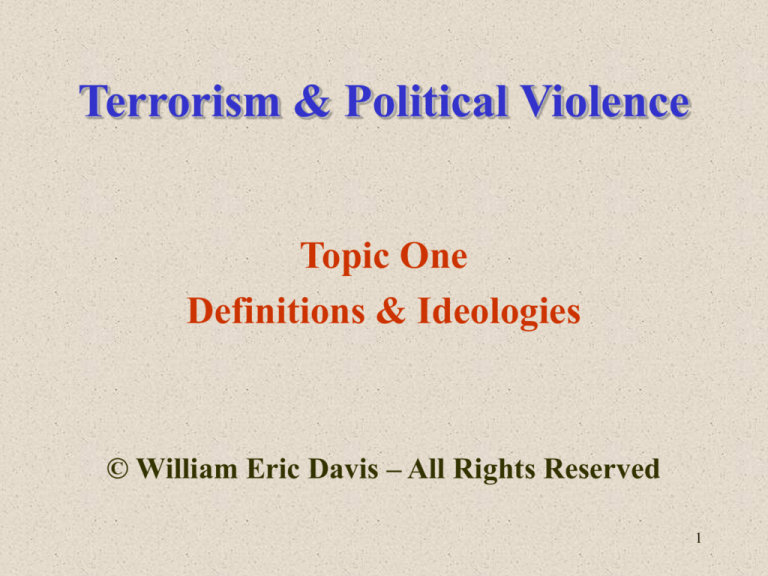
Terrorism & Political Violence
Topic One
Definitions & Ideologies
© William Eric Davis – All Rights Reserved
1
Lecture Outline
I.
Levels of Analysis
II. The various definitions of terrorism and lack of consensus definition.
III. The Ideologies of Terrorists.
IV. [A] POLITICAL and POLICY-BASED IDEOLOGIES
IV. [B] RELIGIOUS EXTREMIST IDEOLOGIES
IV. [C] “Continuing Criminal Enterprises” (“Cashism”)
V.
Common Characteristics of Terrorist Groups
VI. Terrorist Areas of Operation
VII. Support Structures
VIII. Terror Group Organizational Structures
IX. Command and Control
X.
Discussion Questions
2
“Psychopathic”
A person is “psychopathic” when he or she has
lost touch with reality.
Psychopaths are living out a fantasy. An
example includes a person who thinks that
they are an angel doing “God’s work.”
Not all terrorists are psychopaths. In fact, few
are.
3
“Sociopathic”
A person is “sociopathic” when he or she demands
immediate gratification of desires. They have
become intolerant toward delay of goals.
Sociopaths want immediate gratification of
whatever it is they want. Their objective is taken
as a given (neither rational nor irrational) but
they demand immediate satisfaction and will
destroy anything or anyone that is a barrier to
gratification.
Not all terrorists are sociopaths, but most are.
4
INSANITY
(Legal Definition)
A person is “legally” insane (as opposed to
“clinically” insane) when he or she does
NOT know that the crime he or she did
was morally wrong.
They no longer know the difference
between right and wrong.
5
Maximillen Robespierre
Maximillen Robespierre, a leader of the French
Revolution, who coined the term terrorism.
He did not invent the strategy or tactics of terror,
but, he did institute the famous Reign of Terror
(“Regime de Terreur”) as part of the French
revolution and the new revolutionary
government.
6
“The Death of Marat”
by Jacques-Louis David
7
What is Terror?
Definition: Terror is an emotional state of intense fear
caused by specific acts of violence or threats of
violence.
It (deliberately or otherwise) inhibits or destroys the
ability of individuals to function in a society and
possibly the societies ability to function as a whole.
It refers to a “physical” or “physiological” reaction.
8
The Components of Terrorism?
Terrorism has 3 basic (but required)
components:
1. An act or threat of violence.
2. An emotional reaction.
3. Social effects.
9
F.B.I. Definition of Terrorism
“The unlawful use of force or violence against
persons or property to intimidate or coerce a
government, the civilian population, or any
segment thereof, in furtherance of political or
social objectives.”
[Problems: there may be only a “threat” of
violence or force, and there may be no political
or social demands (objectives)].
10
US State Department Definition
“Premeditated, politically motivated
violence perpetrated against noncombatant targets by sub-national groups
or clandestine agents, usually intended to
influence an audience.”
[Problems = terror groups without political
motivations are excluded. No substantive
motivation(s)].
11
US Department of Defense Definition
“The calculated use of violence or threat of violence to
inculcate fear, intended to coerce or to intimidate
governments or societies in the pursuit of goals that
are generally political, religious, or ideological.”
[Problem = better, but too vague. Excludes
physiological and psychological goals. What does
calculated mean?].
12
U.S. D.o.D. Directive 2000.12H
“The calculated use of violence or threat of violence to
attain goals-political, religious, or ideological in
nature-by instilling fear or using intimidation or
coercion. Terrorism involves a criminal act, often
symbolic in nature, intended to influence an audience
beyond the immediate victims.”
[Problem = it leaves out physiological and psychological
goals].
13
United States Legal Code
“Premeditated, politically motivated violence
perpetrated against non-combatant targets by
sub-national groups or clandestine agents.”
[Problem = nations and governments can be
terrorists too, not just “sub-national” groups.
We call it “state terrorism”].
14
United Nations (UN) Description
“Terrorism is a unique form of crime. Terrorist acts
often contain elements of warfare, politics and
propaganda. For security reasons and due to a lack
of popular support, terrorist organizations are
usually small, making detection and infiltration
difficult. Although the goals of terrorists are
sometimes shared by wider constituencies, their
methods are generally abhorred.”
[Problem = too vague and does not produce a
workable typology. The methods are also often
admired by those who benefit from them].
15
British Government Definition
“Terrorism is the use of serious violence against
persons or property, or the threat to use such
violence, to intimidate or coerce a government, the
public, or any section of the public for political,
religious or ideological ends. The terms serious
violence would need to be defined so that it included
serious disruption, for instance resulting from
attacks on computer installations or public
utilities.”
Problem – how to distinguish this from “criminal” acts?
How do we know if their motivation was political,
religious, or ideological or not?]
16
Russian Federation Law 130 FZ
“Terrorism is violence or the threat of violence against individuals or
organizations, and also the destruction (damaging) of or threat to destroy
(damage) property and other material objects, such as threaten to cause
loss of life, significant damage to property, or other socially dangerous
consequences and are implemented with a view to violating public
security, intimidating the population, or influencing the adoption of
decisions advantageous to terrorists by organs of power, or satisfying their
unlawful material and (or) other interests; attempts on the lives of
statesmen or pubic figures perpetrated with a view to ending their state or
other political activity or out of revenge for such activity; attacks on
representatives of foreign states or staffers of international organization
enjoying international protection, and also on the official premises or
vehicles of persons enjoying international protection if these actions are
committed with a view to provoking war or complicating international
relations.”
17
The Terrorist Recognition Handbook
“Terrorism is the calculated use of criminal violence or
threat of violence by a covert or overt individual,
group, entity, special-interest organization, or
government agency specifically designed to target
people, commerce, and/or infrastructures.”
[Problem/Comments – It includes government
agencies, but this definition could include warfare
that the Geneva Convention considers legitimate
warfare].
18
William Eric Davis
“An act or threat of physical violence to persons or
property, motivated either by values, political
objectives, or psychic rewards (like revenge);
directed against property or persons that are not
objectively culpable for grievances or not in a
position to redress the perpetrator’s grievances
directly (e.g., unarmed civilians); where the violence
is expected to have far-reaching psychological
repercussions (including intense fear) beyond the
immediate victim or target of violence.”
-The Road to Evil[Forthcoming]
19
Does the US fit Definition?
20
Some People Consider this Guy to be a Terrorist
IS HE?
21
GENOCIDE versus MASS KILLING
GENOCIDE = political violence motivated
by a desire to exterminate an entire group of
people based on their race, religion, or
beliefs.
MASS MURDER = the killing of a lot of
people, but not intended to make them (and
their race or religion) extinct.
22
There is possibly only 1 way to
enforce a definition of terrorism.
It is this Those who violate the
definition of terrorism forfeit their right
to have rights.
The Geneva Convention on Human Rights
should not apply to terrorists because
they do not respect the rules themselves.
23
The Spock Principle
“The needs of the many outweigh the needs of
the few, or the one.”
“Mr. Spock”
Star Trek II: The Wrath of Kahn:
© Paramount Pictures, 1982.
This collectivism principle has often been
24
used to justify political violence and terrorism.
“Civilization”
In the most comprehensive sense
“civilization” means a regime (society,
system and processes) where disputes are
resolved peacefully and all participants
are willing to accept a loss if they feel
they lost fairly.
This, interestingly, implies democratic
government. Democracy is not fair, but it is
fairer than any alternative because it allows
“the many” to decide the needs of the many,
rather than a small elite doing it.
25
Ideology Definition
An ideology is a conception of the ideal social
order.
Ideologies are born of crisis and feed on
conflict.
People seeking to comprehend and cope with
turbulent times and confusing circumstances
turn to ideologies for explanations and for
programs of action to end “misery”.
26
Four important functions
performed by an Ideology
• Explanatory
• Evaluative
• Orientive (Identification)
• Programmatic
27
The Explanatory Function of an Ideology
An ideology EXPLAINS political phenomena
that would otherwise remain mysterious.
Why is there poverty and misery?
Why are there wars?
What causes depressions?
Different ideologies provide different answers to
these questions.
28
The Evaluation Function
An ideology provides its followers with criteria and
standards of evaluation.
That is, it provides a rule for deciding what is right or
wrong, good or bad.
For example, are class and economic differences a good
or bad thing?
The answer depends on whether equality is most
important to you (egalitarians) or prosperity and
liberty (libertarians).
29
The Identification (Orientive) Function
An ideology provides self-identification. That is, it
orients its adherents giving them a sense of who
they are and where they belong.
It provides a social and cultural compass with which
to define and affirm their individual and collective
identity.
An ideology defines the person and what they are
about—and gives them something around which
to socialize with like-minded people.
30
The Programmatic Function
An ideology supplies its followers with a
political program.
The program provides an answer to the questions:
• “What is to be done?”
• “Who is to do it?”
• “What tactics should be used to do it?”
31
The 3 “Basic” Categories of Ideology
Political and Policy Ideologies
Religious Ideologies
“Cashism” (Greed)
32
Political / Policy Based Ideologies
Marxist-Leninist/Communism
Stalinist Communism
Maoist Communism
Castro and Guevarist Communism
Socialism
Anti-Globalization
Environmentalism
Animal Rights
Fascism/Neo-Fascism (National Socialism)
European Neo-Nazism
American Neo-Nazism
Anarchist/Nihilist
Ethnic & National Independence Movements
33
Religious & Extremist Ideologies
Islamic Extremism (Wahabi)
Militant Zionism
Christian Extremism
Anti-Abortion/Right to Life
Hindu Extremism
Sikh Extremism
Messianic Salvation/Apocalyptic Cultism
Occultism
Paganism/Animism
34
Continuing Criminal Enterprises (CCE)
[Cold Hard “Cashism”]
Narco-Terrorism (e.g., Drug Cartels)
Politically Active CCE
Non-Political CCE
Mercenaries
35
Pablo Escobar
Common Characteristics of Terrorists
1. Terrorists use violence.
2. Terrorists operate in all environments.
3. Terrorists operate covertly.
4. Terrorists are well organized
5. Terrorists act deliberately.
6. Terrorists are highly mobile.
7. Terrorists use short-duration tactics.
8. Terrorists are media dependent.
9. Terrorists engage in “Guilt Transference”.
36
Terrorist Areas of Operation
1. Local Terrorists
2. Regional Terrorists
3. National (Domestic) Terrorists
4. Transnational Terrorists
5. International Terrorists (Global)
37
Support Structures
1. State Terrorism
2. State-Directed Terrorism
3. State-Supported Terrorism
4. Independent Terrorism
38
The subgroups within a terror group
Senior Leaders
Field Leaders
Active Operatives
Active Supporters
Passive Supporters
39
Command and Control
Centralized Authority Structure -- Provides
terror cells and members with ALL support:
financial, intelligence, and supplies come from
a single source.
Decentralized Authority Structure -- Allows
groups at the cell level or individual level to
provide for themselves with minimal direction
or support from the group’s top leadership.
40



